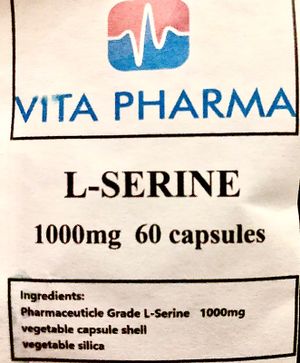Serine: Difference between revisions
Notjusttired (talk | contribs) m (Text replacement - "|last2=" to " | last2 = ") |
Notjusttired (talk | contribs) m (Text replacement - " author-link3=" to " author-link3 = ") |
||
| (23 intermediate revisions by the same user not shown) | |||
| Line 1: | Line 1: | ||
[[File:L-serine amino acid.jpg|alt=Photo of a label of L-serine supplements|thumb]] | [[File:L-serine amino acid.jpg|alt=Photo of a label of L-serine supplements|thumb]] | ||
'''L-serine''' is a non-essential amino acid which is a precursor to several other amino acids (including glycine and [[L-cysteine]], and of some cell membrane lipids.<ref>{{Cite journal|last=de Koning|first=Tom J | last2 = Snell|first2=Keith|last3=Duran|first3=Marinus | last4 = Berger|first4=Ruud | last5 = Poll-The|first5=Bwee-Tien | last6 = Surtees|first6= | '''L-serine''' is a non-essential amino acid which is a precursor to several other amino acids (including glycine and [[L-cysteine]], and of some cell membrane lipids.<ref>{{Cite journal | last = de Koning | first = Tom J | last2 = Snell | first2 = Keith | last3 = Duran | first3 = Marinus | last4 = Berger | first4 = Ruud | last5 = Poll-The | first5 = Bwee-Tien | last6 = Surtees | first6 = Robert | date = 2003-05-01 | title = L-serine in disease and development.|url=https://www.ncbi.nlm.nih.gov/pmc/articles/PMC1223326/|journal=Biochemical Journal|volume=371|issue=Pt 3 | pages = 653–661|doi=10.1042/BJ20021785|issn=0264-6021|pmc=1223326|pmid=12534373}}</ref><ref name="Ito2014" /> Ito et al. 2014 report that it has an extensive role in protein synthesis and intracellular metabolism.<ref name="Ito2014" /> | ||
==Potential uses == | ==Potential uses == | ||
| Line 8: | Line 8: | ||
==Evidence== | ==Evidence== | ||
Two small randomized double-blinded crossover studies (clinical trials) by Ito et al. (2014) found that a dose of 3g (3000mg) or L-serine improved sleep maintenance and reduced time until sleep compared to a placebo treatment.<ref name="Ito2014">{{Cite journal|last=Ito|first=Yukihiko | last2 = Takahashi|first2=Satomi|last3=Shen|first3=Manzhen | last4 = Yamaguchi|first4=Kohji | last5 = Satoh|first5=Makoto|date=2014-08-22|title=Effects of L-serine ingestion on human sleep | url =https://www.ncbi.nlm.nih.gov/pmc/articles/PMC4155056/|journal=SpringerPlus|volume=3|doi=10.1186/2193-1801-3-456|issn=2193-1801|pmc=4155056|pmid=25197619}}</ref> | Two small randomized double-blinded crossover studies (clinical trials) by Ito et al. (2014) found that a dose of 3g (3000mg) or L-serine improved sleep maintenance and reduced time until sleep compared to a placebo treatment.<ref name="Ito2014">{{Cite journal | last = Ito | first = Yukihiko | last2 = Takahashi | first2 = Satomi | last3 = Shen | first3 = Manzhen | last4 = Yamaguchi | first4 = Kohji | last5 = Satoh | first5 = Makoto | date = 2014-08-22 | title = Effects of L-serine ingestion on human sleep | url =https://www.ncbi.nlm.nih.gov/pmc/articles/PMC4155056/|journal=SpringerPlus|volume=3|doi=10.1186/2193-1801-3-456|issn=2193-1801|pmc=4155056|pmid=25197619}}</ref> | ||
==ME/CFS== | ==ME/CFS== | ||
A study by Huth et al. (2020) found increased levels of L-serine in the [[blood]] serum of ME/CFS patients compared to healthy controls, and decreased levels of serine in the urine of ME/CFS patients.<ref>{{Cite journal|last=Huth|first=Teilah Kathryn| | A study by Huth et al. (2020) found increased levels of L-serine in the [[blood]] serum of ME/CFS patients compared to healthy controls, and decreased levels of serine in the urine of ME/CFS patients.<ref>{{Cite journal | last = Huth | first = Teilah Kathryn | authorlink = Teilah Huth | last2 = Eaton-Fitch | first2 = Natalie | author-link2 = Natalie Eaton-Fitch | last3 = Staines | first3 = Donald | author-link3 = Donald Staines | last4 = Marshall-Gradisnik | first4 = Sonya | author-link4 = Sonya Marshall-Gradisnik | date = Dec 2020 | title = A systematic review of metabolomic dysregulation in Chronic Fatigue Syndrome/Myalgic Encephalomyelitis/Systemic Exertion Intolerance Disease (CFS/ME/SEID)|url=https://translational-medicine.biomedcentral.com/articles/10.1186/s12967-020-02356-2|journal=Journal of Translational Medicine|language=en|volume=18|issue=1|pages=198|doi=10.1186/s12967-020-02356-2|issn=1479-5876|pmc = 7222338|pmid=32404171|access-date=|quote=|via=}}</ref> | ||
==Risks and side effects== | ==Risks and side effects== | ||
Latest revision as of 20:09, April 2, 2023
L-serine is a non-essential amino acid which is a precursor to several other amino acids (including glycine and L-cysteine, and of some cell membrane lipids.[1][2] Ito et al. 2014 report that it has an extensive role in protein synthesis and intracellular metabolism.[2]
Potential uses[edit | edit source]
L-serine is of potential use for insomnia or sleeping problems.[2]
Theory[edit | edit source]
Evidence[edit | edit source]
Two small randomized double-blinded crossover studies (clinical trials) by Ito et al. (2014) found that a dose of 3g (3000mg) or L-serine improved sleep maintenance and reduced time until sleep compared to a placebo treatment.[2]
ME/CFS[edit | edit source]
A study by Huth et al. (2020) found increased levels of L-serine in the blood serum of ME/CFS patients compared to healthy controls, and decreased levels of serine in the urine of ME/CFS patients.[3]
Risks and side effects[edit | edit source]
Costs and availability[edit | edit source]
L-serine is inexpensive and available over the counter as a capsule or powder.
Learn more[edit | edit source]
See also[edit | edit source]
References[edit | edit source]
- ↑ de Koning, Tom J; Snell, Keith; Duran, Marinus; Berger, Ruud; Poll-The, Bwee-Tien; Surtees, Robert (May 1, 2003). "L-serine in disease and development". Biochemical Journal. 371 (Pt 3): 653–661. doi:10.1042/BJ20021785. ISSN 0264-6021. PMC 1223326. PMID 12534373.
- ↑ 2.0 2.1 2.2 2.3 Ito, Yukihiko; Takahashi, Satomi; Shen, Manzhen; Yamaguchi, Kohji; Satoh, Makoto (August 22, 2014). "Effects of L-serine ingestion on human sleep". SpringerPlus. 3. doi:10.1186/2193-1801-3-456. ISSN 2193-1801. PMC 4155056. PMID 25197619.
- ↑ Huth, Teilah Kathryn; Eaton-Fitch, Natalie; Staines, Donald; Marshall-Gradisnik, Sonya (December 2020). "A systematic review of metabolomic dysregulation in Chronic Fatigue Syndrome/Myalgic Encephalomyelitis/Systemic Exertion Intolerance Disease (CFS/ME/SEID)". Journal of Translational Medicine. 18 (1): 198. doi:10.1186/s12967-020-02356-2. ISSN 1479-5876. PMC 7222338. PMID 32404171.


